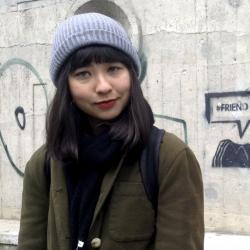The colour, I am certain, has never existed before, and will never exist again. It has something to do with blue, grey, purple, orange, and yellow and yet is none of them. It coats the sky to our left as we drive up Route One, appearing through the mist of a far-off thunderstorm, backlit by the sun. It’s the whole sky, then it’s gone—the colour of a moment.
Google Maps calculates the route from Reykjavík to Rif at about 2.5 hours. By the time we approach the tiny town of Rif, we’ve been on the road for nearly five hours, moving at a deliberately easy pace between hot spring soaks and wild mountain walks. We float across the quiet northern side of the Snæfellsnes peninsula, through Grundarfjörður, Ólafsvík, and finally, to Rif.
In Rif, there are two roads that join into one. On the harbour side of the road is The Freezer, a former fish factory turned hostel, theatre and artist residency space, where we’ll be staying for the next two nights. It’s tucked back from the road, but the red exterior and the word “FREEZER” painted across the wall make it easy to find.
Chick(en)s for free
Dóra, one of the managers at the Freezer, is equally easy to find. She sits in one of four mixed-and-matched couch arrangements in the giant lounge and lobby. She greets us like old friends: “with a smile,” as the owner of the Freezer, Kári, had mentioned in our earlier correspondence. At the coffee table with her are two other women busily clicking at their computers. They’re working on a production of ‘Journey To The Centre Of The Earth’, Jules Verne’s 1864 subterranean science fiction novel that begins in the Snæfellsjökull stratovolcano.
“I’ll show you around,” says Dóra. “This is a chicken,” she says, motioning to a caged plastic animal that sits at the table. “We borrowed it. I need to return it.” She nudges a wad of newspaper toward the front of the cage, “I’m kind of scared of it.”

Next, she leads us through a large door at the back. It opens into a room twice as large as the lobby space. The walls are painted black, and we stand facing a stage. To the right is a smaller room of stacked school chairs. The “small theatre” is a room that once functioned as the hostel-theatre’s namesake—the freezer.
After the tour, we ask for a food recommendation and Dóra immediately calls the restaurant (the restaurant) in Ólafsvík to see if they are open tonight. “They are!” she exclaims. “I’ve told them you’re coming.” As we’ll continue to discover, choice is overruled by simplicity in these parts.
And so, it’s decided. We drive to the restaurant, which is called Hraun (“lava,” in English), and eat pan-fried char and chocolate cake. On the way back to Rif we catch a glimpse of some northern lights and decide to bypass the town to seek more of the sky’s mighty show. But, as usual with the northern lights, as soon as we go looking they’ve disappeared behind the clouds. Instead, we retreat to watch ‘Friday’ at the Freezer.
Til Sölu
The next morning in Rif we head down the street to get some coffee and tea from the local grocery store. Or, what was the grocery store. It still shows up on GoogleMaps, but all that’s left of it now are some cardboard cutouts of ice cream cones taped to the windows.
After a walk through the cool, salt-in-the-air streets we decide to drive five minutes down the peninsula to the local coffee shop in Hellissander. Or, what was the local coffee shop. It too still shows up on GoogleMaps. What was once Kaffi Síf looks promising on the approach—a cosy detached cottage with lace in the windows, and a giant sign that looks like it was made in Microsoft Paint. But instead of ice cream, we find taped to its windows two sheets of computer paper: one reads “Til Sölu,” and the other one “For Sale :).”
There’s a store in town that seems to double as the local hangout for the shopkeeper and friends. It carries everything from Stonewall Kitchen jams to winter gloves. There’s also an N1 gas station where you can pick up a slice of “happy marriage” cake and a hearty bowl of vegetable soup, or a handmade lopapeysa “by Dagny.” Again, simplicity rules over choice.
Rif and Hellissandur are towns that have what you need, and not a thing more. They are ambient with their surroundings—from the thick Atlantic on one side to the glacial and volcanic mountain range on the other. They have hot soup, warm beds, and petrol to get between the two. They are places where most is left untouched and questions are left unanswered. Like: Why is the road painted in giant sections of blue, orange, and green? And what do we call that strange colour of sky?
Buy subscriptions, t-shirts and more from our shop right here!






















